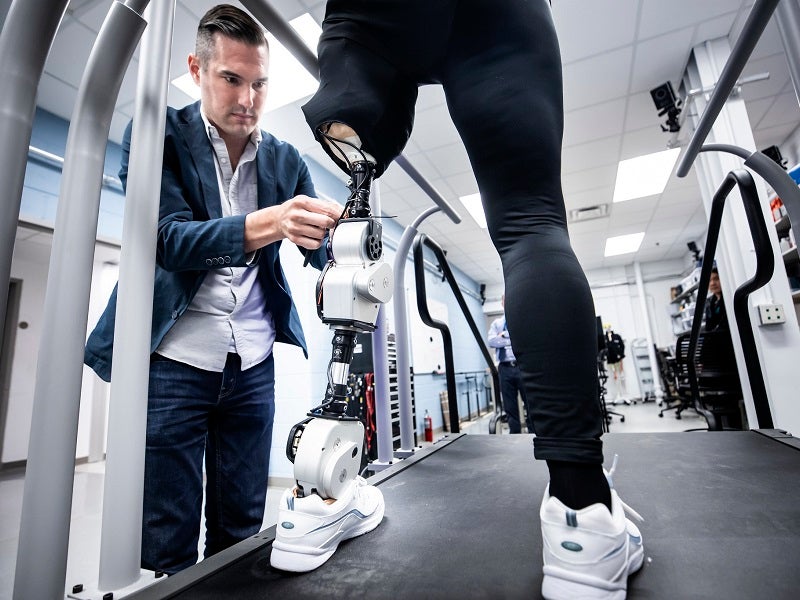
Already a dominant influence in the development of prosthetic arms, open sourcing is now poised to redefine prosthetic leg design through an initiative led by the University of Michigan and the Shirley Ryan AbilityLab.
University of Michigan assistant professor Elliot Rouse and AbilityLab director Levi Hargrove unveiled their open-source robotic prosthetic leg (OSL) at Amazon’s Re:MARS conference in Las Vegas in June 2019.

Discover B2B Marketing That Performs
Combine business intelligence and editorial excellence to reach engaged professionals across 36 leading media platforms.
The device, powered by the Raspberry Pi single-board computer, uses artificial intelligence (AI) to work out what it is the user is about to do next and respond accordingly. It senses contraction signals from the remaining muscles it is connected to, and then uses this information to cut and pivot as needed, learning how to improve at every turn.
Rouse and Hargrove aim to unite the fragmented field of prosthetic legs by making it possible for any research team to build the device they’ve developed. Their website, opensourceleg.com, contains instructions on how to make, assemble, and control the OSL.
Drone-inspired design
Through this website, researchers are able to access the specific materials used to construct the OSL, alongside the vendors they can access these materials through. The leg has been designed using motor technology developed for the drone industry, with flat pancake-style motors inside which trade speed for torque. This allows the user to have more efficient control over their prosthetic and lets them walk more naturally.
Once the leg is constructed, researchers using the OSL can download the AI software, which tells the leg how to move. The resulting algorithmic data from different users of the OSL is also designed to be open-source. The common platform enables direct comparisons of different uses of the software, which researchers can then merge and build upon.

US Tariffs are shifting - will you react or anticipate?
Don’t let policy changes catch you off guard. Stay proactive with real-time data and expert analysis.
By GlobalDataThe full bionic leg, made according to the website’s specifications, will cost each manufacturer $28,500.
As well as being robust and fairly inexpensive – the full bionic leg, made according to the website’s specifications, will cost each manufacturer $28,500 – the system is designed to be straightforward and easy to manufacture. Videos online detail each step of the building process.
The designers also focused on making the OSL portable and practical. The same physical structure can act as a knee or an ankle depending on the individual needs of a patient, meaning OSL can be used by above and below-the-knee amputees. An on-board power supply and control electronics allow it to be tested anywhere, meaning trials of the device are not confined to laboratory settings.
Rouse said: “Our Open-Source Bionic Leg will enable investigators to efficiently solve challenges associated with controlling bionic legs across a range of activities in the lab and out in the community. In addition, we hope our bionic leg will unite researchers with a common hardware platform and enable new investigators from related fields to develop innovative control strategies.”
Saving researchers millions
Researchers who work directly with disabled people often start from scratch, building their own robotic system. The OSL could help to completely bypass this process, and the associated R&D costs, which can reach millions of dollars. Clinicians working with the OSL will be able to conduct their research underneath the same system, streamlining the device development process and bringing better healthcare solutions to patients.
Hargrove said: “While the designs and code are free, the leg is still a high-end, state-of-the-art machine. It’s a unique plug-and-play system that allows scientists to avoid research and development costs in the millions of dollars and immediately begin testing on prosthetics for the knee and ankle. It effectively lowers the barriers to entry for researchers.”
Rouse and Hargrove have stressed that the OSL is intended as a research tool and not as a build-at-home device for everyday patient use. However, patients involved in the project are encouraged to help improve the design and built the AI’s knowledge through their feedback in trials. Corporate companies are also invited to prototype the leg with their own parts to enhance the design.
While the designs and code are free, the leg is still a high-end, state-of-the-art machine.
Medical devices stand out from the software and hardware of other industries, in that the technology has an ethical dimension. While it’s difficult in an increasingly interconnected world, people can choose to opt-out of other modern technologies such as smartphones or streaming. But it’s impossible to opt-out of healthcare.
By open-sourcing their work, medical device researchers aren’t just able to collaborate across the globe and gain stronger data than they would have working privately and alone. Through the sharing of data and ideas, they have the significant ability to reduce patient suffering and improve people’s quality of life.
Rouse said: “This represents the future of research – rapid prototyping of open-source robotic hardware and embedded systems with shared code.”





